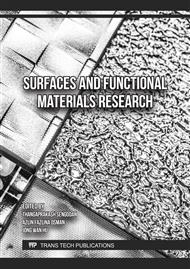[1]
V.M. Venkata Naga, S.A. Alidokht, N. Sharifi M.E. Makowiec, P. Stoyanov, C. Moreau, R.R. Chromik, Room and elevated temperature sliding wear of high velocity oxy-fuel sprayed Diamalloy3001 coatings, Tribology Int. 178 Part A (2023) 108069.
DOI: 10.1016/j.triboint.2022.108069
Google Scholar
[2]
F. Ternero, E.S. Caballero, R. Astacio, J. Cintas, J.M. Montes, Nickel porous compacts obtained by medium-frequency electrical resistance sintering, Materials 13 (2020) 1-15.
DOI: 10.3390/ma13092131
Google Scholar
[3]
M. Cotell, J.A. Sprague, F.A. Smidt R.C, Thermal spray coating, ASM handbook surface engineering 5 (1994) 497–509.
Google Scholar
[4]
Y. Gao, Characterization and mechanical properties for Diamalloy 3001 and Diamalloy 3002NS thermally sprayed coatings, Master Thesis, Department of Mining and Materials Engineering McGill University (2020) 1–134.
Google Scholar
[5]
H. Guo, Y. Wang, E. Hao, B. Li, CoMoCrSi coatings prepared by high-velocity oxygen fuel spraying: microstructure and mechanical properties at elevated temperatures up to 800 °C, Mater, Res, Express 6 (2020) 1265e9.
DOI: 10.1088/2053-1591/ab6374
Google Scholar
[6]
C.D. Prasad, S. Joladarashi, M.R. Ramesh, M.S. Srinath, B.H. Channabasappa, Microstructure and tribological behavior of flame sprayed and microwave fused CoMoCrSi/CoMoCrSi–Cr3 C2 coatings, Materials Research Express 6 (2018) 026512.
DOI: 10.1088/2053-1591/aaebd9
Google Scholar
[7]
American Bureau of Shipping, ABS Guide for classification and certification of subsea production systems equipment and components (2017) Information on: http://www.eagle.org.
Google Scholar
[8]
M. Iannuzzi, A. Barnoush, R. Johnsen, Materials and corrosion trends in offshore and subsea oil and gas production, Materials Degradation 1 (2017) 1-11.
DOI: 10.31224/osf.io/qj65n
Google Scholar
[9]
Norman E. Dowling, Mechanical behavior of materials, Fourth Edition, 2013.
Google Scholar
[10]
Special metals corporation, High-performance alloys for resistance to aqueous corrosion, Special metals corporation (2000) 1–61.
Google Scholar
[11]
H. Zhou, Y. Wang, T. Ma, Effect of silicon addition on corrosion behavior of carbon steel rebar in sulfuric acid environment, International Journal Electrochemical Science 15 (2020) 3003–3012.
DOI: 10.20964/2020.04.22
Google Scholar
[12]
B.J. Saldanha, M.A. Streicher, Effect of silicon on the corrosion resistance of iron in sulfuric acid, Mater. Performance 25 (1986).
Google Scholar
[13]
F. Juárez-López, R. Cuamatzi-Meléndez, Á. de J. Morales-Ramírez, M. García-Hernández, M.L. Carrera-Jota, Microstructural evolution and densification of Co-based alloy powder by spark plasma sintering for high-hardness applications, Coatings 14 4 (2024) 479.
DOI: 10.3390/coatings14040479
Google Scholar
[14]
V.N.V. Munagala, S.A. Alidokht, N. Sharifi, M.E. Makowiec, P. Stoyanov, C. Moreau, R.R. Chromik, Room and elevated temperature sliding wear of high velocity oxy-fuel sprayed Diamalloy3001 coatings, Tribology International 178 (2023) 108069.
DOI: 10.1016/j.triboint.2022.108069
Google Scholar
[15]
S. Alidokht, Y. Gao, B.C.N.M de Castillo, N. Sharifi, Microstructure and mechanical properties of Tribaloy coatings deposited by high-velocity oxygen fuel, Journal of Materials Science 57 (2022) 20056–20068.
DOI: 10.1007/s10853-022-07843-z
Google Scholar
[16]
A. Śliwa, J. Mikuła, L.A. Dobrzański, FEM application for modelling of PVD coatings properties, Journal of achievements of materials and manufacturing engineering 41 1–2 (2010) 164–171.
Google Scholar
[17]
J. Li, W. Beres, Three-dimensional finite element modelling of the scratch test for a TiN coated titanium alloy substrate, Wear 260 (2006) 1232–1242.
DOI: 10.1016/j.wear.2005.08.008
Google Scholar
[18]
D. Ashutosh, J. Francis, Finite element modelling of surface stresses in coatings under single particle impact, International Journal of Engineering Research & Technology 2 (2013) 3421–3426.
Google Scholar
[19]
N.A. Dolgov, N. Tonchev, Modelling and finite element analysis of tensile testing for the coated specimens, International Scientific Journal Materials Science Non-Equilibrium Phase Transformations 4 (2018) 122–125.
Google Scholar
[20]
X. Ma, W. Zhang, Z. Chen, D. Yang, J. Jiang, L. Song, J. Tu, H. Zhai, Elastoplastic deformation and fracture behavior of Cr-Coated Zr-4 alloys for accident tolerant fuel claddings, Frontiers in Energy Research 9 (2021) 1–12.
DOI: 10.3389/fenrg.2021.655176
Google Scholar
[21]
T. Tiirats, N. Chevaugeon, N. Moës, C. Stolz, N. Marouf, E. Desdoit, How to efficiently apply soft thin coating to existing finite element contact model, Finite Elements in Analysis and Design 177 (2020) 103420.
DOI: 10.1016/j.finel.2020.103420
Google Scholar
[22]
A. Ouladbrahim, I. Belaidi, S. Khatir, E. Magagnini, R. Capozucca, M.A. Wahab, Prediction of Gurson damage model parameters coupled with hardening law identification of steel X70 pipeline using neural network, Metals and Materials International 28 (2022) 370–384.
DOI: 10.1007/s12540-021-01024-4
Google Scholar
[23]
A.A. Benzerga, J.B. Leblond, A. Needleman, V. Tvergaard, Ductile failure modeling, International Journal of Fracture 201 (2016) 29–80.
DOI: 10.1007/s10704-016-0142-6
Google Scholar
[24]
M.M. Shahzamanian, Anisotropic Gurson‐Tvergaard‐Needleman plasticity and damage model for finite element analysis of elastic‐plastic problems, International Journal of Numeric Methods in Engineering. 115 13 (2018) 1527–1551.
DOI: 10.1002/nme.5906
Google Scholar
[25]
R.A. Yildiz, Numerical analysis of the damage evolution of DP600 steel using Gurson–Tvergaard–Needleman model, Steel Research International 94 (2022) 1-28.
DOI: 10.1002/srin.202200147
Google Scholar
[26]
E.R. Sérgio, F.V. Antunes, D.M. Neto, M.F. Borges, Study on the influence of the Gurson–Tvergaard–Needleman damage model on the fatigue crack growth rate, Metals 11 8 (2021) 1183.
DOI: 10.3390/met11081183
Google Scholar
[27]
Dassault Systemes, Abaqus 6.14. Theory Guide, Simulia 6.14 (2014).
Google Scholar
[28]
Winsteel group limited, 42-inch LSAW Steel Pipe, Winsteel group limited (2024) Information on https://winsteelpipes.com/product/3051.html
Google Scholar
[29]
O. Lavigne, A. Kotousov, V. Luzin, Microstructural, mechanical, texture and residual stress characterizations of X52 pipeline steel, Metals 7 8 (2017).
DOI: 10.3390/met7080306
Google Scholar
[30]
A.L. Gurson, Continuum theory of ductile rupture by void nucleation and growth: Part I—Yield criteria and flow rules for porous ductile media, Journal of Engineering Materials Technology 99 1 (1997) 2–15.
DOI: 10.2172/7351470
Google Scholar
[31]
I.I. Cuesta, J.M. Alegre, H. Barbáchano, Aplicación del modelo de daño de Gurson-Tvergaard-Needleman (GTN) para la simulación del ensayo miniatura de punzonado sobre probetas prefisuradas, Revista de Metalurgia 46 (2010) 53–63.
DOI: 10.3989/revmetalmadrid.05xiipms
Google Scholar
[32]
V. Tvergaard, On localization in ductile materials containing spherical voids, International Journal of Fracture 18 4 (1982) 237–252.
DOI: 10.1007/bf00015686
Google Scholar
[33]
R. Kiran, K. Khandelwal, Gurson model parameters for ductile fracture simulation in ASTM A992 steels, Fatigue and Fracture of Engineering Materials and Structures 37 2 (2014) 171–183.
DOI: 10.1111/ffe.12097
Google Scholar


